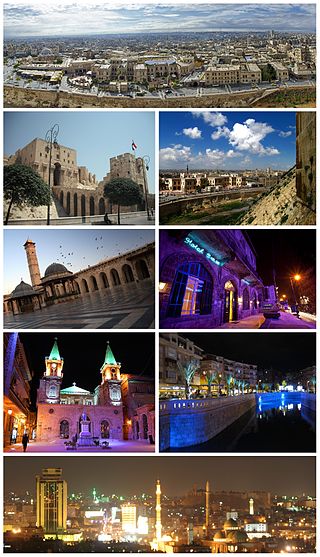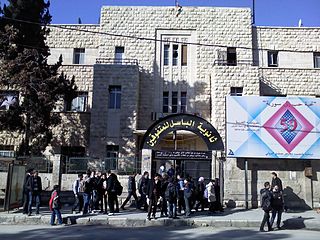
Transport in Syria is possible by rail, road, air or rivers, both public and private. Syria is an Asian country with a well-developed rail network (2,052 km) and a highway system (782 km). Main international airport is the Damascus International Airport in the capital, Damascus.

Aleppo is a city in Syria, which serves as the capital of the Aleppo Governorate, the most populous governorate of Syria. With an estimated population of 2,098,000 residents as of 2021, it was Syria's largest city until its population was surpassed by Damascus, the largest in Syria's northern governorates and also one of the largest cities in the Levant region.

Latakia is the principal port city of Syria and capital city of the Latakia Governorate located on the Mediterranean coast. Historically, it has also been known as Laodicea in Syria or Laodicea ad Mare. In addition to serving as a port, the city is a significant manufacturing center for surrounding agricultural towns and villages. According to 2023 estimate, the population of the city is 709,000, its population greatly increased as a result of the ongoing Syrian Civil War, which led to an influx of internally displaced persons from rebel held areas. It is the 4th-largest city in Syria after Aleppo, Damascus, and Homs. It borders Tartus to the south, Hama to the east, and Idlib to the north, and Cape Apostolos Andreas, the north-eastern tip of Cyprus, is about 109 kilometres (68 mi) away.

Education in the Syrian Arab Republic is given the necessary attention and care by the Syrian state, as the Syrian Constitution guarantees the right to education to every citizen, which is compulsory and free at primary level. It is free but not compulsory at the secondary level and higher education is available for a symbolic fee. the primary level includes 3 stages, 1 which include grades 1 to 6, while 2 includes grades 7 to 9,and lastly 3 grades 10 to 12

Syrian Jews are Jews who lived in the region of the modern state of Syria, and their descendants born outside Syria. Syrian Jews derive their origin from two groups: from the Jews who inhabited the region of today's Syria from ancient times, and sometimes classified as Mizrahi Jews. Mizrahi is a generic term for the Jews with an extended history in Western Asia or North Africa); and from the Sephardi Jews who fled to Syria after the Alhambra Decree forced the expulsion of the Jews from Spain in 1492.
The Armenians in Syria are Syrian citizens of either full or partial Armenian descent.

Christians in Syria made up about 10% of the pre-war Syrian population. The country's largest Christian denomination is the Greek Orthodox Church of Antioch, closely followed by the Maronite Church and the Assyrian Church of the East; the cities of Damascus and Aleppo are believed to have the largest number of Christians in Syria. There is a small minority of Protestants in the country.

Syrian Jews had predominantly two origins: those who inhabited Syria from early times and the Sephardim who fled to Syria after the expulsion of the Jews from Spain in 1492 CE. There were large Jewish communities in Aleppo, Damascus, and Qamishli for centuries. In the early 20th century, a large percentage of Syrian Jews immigrated to Palestine, the U.S. and Latin America. The largest Syrian-Jewish community is now located in Israel and is estimated to number 80,000.

Ottoman Syria refers to divisions of the Ottoman Empire within the region of Syria, usually defined as being east of the Mediterranean Sea, west of the Euphrates River, north of the Arabian Desert and south of the Taurus Mountains.
Abdul Rahman Mowakket is a contemporary sculptor from Syria.
Syria is a semi-arid country with scarce water resources. The largest water-consuming sector in Syria is agriculture. Domestic water use is only about 9% of total water use. A big challenge for Syria is its high population growth, with a rapidly increasing demand for urban and industrial water. In 2006, the population of Syria was 19.4 million with a growth rate of 2.7%.

The 1947 anti-Jewish riots in Aleppo were an attack on Syrian Jews in Aleppo, Syria in December 1947, following the United Nations vote in favour of partitioning Palestine. The attack, a part of an anti-Jewish wave of unrest across the Middle East and North Africa, resulted in some 75 Jews murdered and several hundred wounded. In the aftermath of the riots, half the city's Jewish population fled the city.
The Aleppo Artillery School massacre was a sectarian massacre of Syrian Army cadets on 16 June 1979. It was carried out by a handful of members of the Fighting Vanguard led by Adnan Uqlah, without the permission of the Fighting Vanguard's leader, Hisham Jumbaz. The Muslim Brotherhood in Syria was not responsible for the attack and condemned it after the fact, but the attack was used as a pretext for a large scale crackdown against it.

University of Aleppo is a public university located in Aleppo, Syria. It is the second largest university in Syria after the University of Damascus.
The Aleppo University bombings took place on 15 January 2013, during the Syrian Civil War. The bombings killed at least 87 people at the Aleppo University, including students and children. The explosions reportedly struck an area between the University of Aleppo's halls of residence and the faculty of architecture, on the first day of exams. Both sides blamed each other for the explosions. While the university has been a center of antigovernment demonstrations, it is also in a government-held area, with neither side seemingly having had an obvious reason to strike. It was also a refuge for over 30,000 civilians fleeing the fighting in Aleppo.
The following is a timeline of the history of the city of Aleppo, Syria.
The Aleppo Centre for Culture and Arts is a proposed project for a cultural complex-institute in Aleppo, Syria. The complex will be home to the new National Library of Aleppo and the Aleppo Opera House. The location of the proposed complex is near the Saadallah al-Jabiri Square, at the heart of Aleppo city.

The Club d'Alep is a social club of Aleppo which was founded in 1945 and located in a former residential mansion in the city's Azizieh district. The club has been celebrated internationally for the quality and authenticity of its Aleppine cuisine.
The Ministry of Higher Education and Scientific Research is a department of the Government of Syria that is responsible for maintaining and implementing government policies in higher education in Syria.









